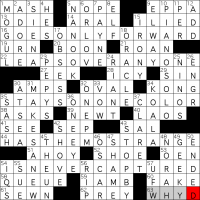crossword 3:26
meta 0:05
 hello and welcome to week #284 of matt gaffney’s weekly crossword contest, “Piece Out”. in honor of the world chess championships, we’re getting three weeks of chess metas this month, of which this easy-peasy puzzle is the first. this week’s instructions inform us that One of the six pieces in chess is missing from this puzzle’s theme. Which one is it? well, the five 15-letter theme answers are all clued {A CERTAIN CHESS PIECE…}:
hello and welcome to week #284 of matt gaffney’s weekly crossword contest, “Piece Out”. in honor of the world chess championships, we’re getting three weeks of chess metas this month, of which this easy-peasy puzzle is the first. this week’s instructions inform us that One of the six pieces in chess is missing from this puzzle’s theme. Which one is it? well, the five 15-letter theme answers are all clued {A CERTAIN CHESS PIECE…}:
- GOES ONLY FORWARD: that’s a pawn.
- LEAPS OVER ANYONE: knight.
- STAYS ON ONE COLOR: bishop.
- HAS THE MOST RANGE: queen
- IS NEVER CAPTURED: king.
all that’s left is the rook, which is the answer to the meta. nothing to it.
so how’s that world championship match going? it’s quiet so far, with the first two games ending in draws. hopefully the fireworks are still to come.
bonus chess content: OEN is clued as {Middle name of Magnus Carlsen (reverses to a movie role often seen in crosswords}. nice way to justify some iffy fill there! (i’ve seen OEN clued as a wine prefix, so it’s legit enough, just… weak.)
how’d you like this one? to me it felt like matt was just whetting our appetites for more serious chess puzzles later in the month.
Thanks, Joon. 585 correct entries this week.
I had to be a little careful with the phrasing on the knight’s clue, since the rook and king do leap over each other between zero and two times per game.
To be even more pedantic about it, it’s arguably the King who leaps over the Rook in the course of castling (the Rook moves to a square it could reach even if the King didn’t move at all, whereas the King moves to the other side of the Rook, which is a square it could not ordinarily reach in a single move).
If we’re going to be pedantic we might as well get it right: it would be the rook that leaps over the king, since technically the king must be moved first if you’re castling. The reason being that, as you point out, Rh1-f1 would be a legal move in a position where O-O would also be legal (white castling kingside here obviously), so you’re supposed to slide your king over two squares first, making your intention clear. The rook then does the leaping.
I had opponents do this incorrectly probably a dozen times in tournament play but never called it, and I don’t think I ever saw anyone call it. I don’t even think a tournament director would enforce it even though it’s a rule.
OK, that’s a reasonable way to look at it. The way I looked at it was: disregarding FIDE’s technicalities on how the pieces are to be moved, which, as you point out, were enacted for reasons external to the game itself, if you just consider the movements involved, there are a couple of ways to describe what’s happening.
1) The Rook moves next to the King and the King vaults to the other side of the Rook.
2) The King moves two squares towards the Rook, and the Rook jumps to the other side of the King.
Described the first way, castling flouts two of the conventions that generally apply to chess: a) two pieces are moved on the same turn and b) the King jumps over another piece. Described the second way, it flouts three conventions: a) two pieces are moved on the same turn, b) the King moves two squares, and c) the Rook jumps over another piece. Thus, by the law of parsimony, the former description is preferable.
However, ’tis a moot and trivial point (except insofar as needed to justify my entry this week).
Historically the King *could* make a double move on its first turn, even jumping over a piece or pawn en route to its destination. Rf1/Kg1 and Rd1/Kc1 were such common setups for both White and Black that both sides would usually do this and eventually the pair was abbreviated to a single special move. (So yes, originally the Rook did move first.)
OK, so I guess we know who will be doing well in the next two chess-related metas!
Most interesting thing to me was to read the Wikipedia entry on chess pieces and see the opprobrium directed at the use of the word “castle” to refer to a “rook.” As someone with very little chess experience, I had always used the two interchangeably.
“Castle” is majorly frowned up on in the chess world, but it’s not as bad as “horse.” Even “horsey” is better than “horse.”
Where does “pony” fall on the spectrum of “things not to call a knight?”
Chessmasters argued over “horsey” and “pony” until one said “Let’s call it a knight.”
I can’t top that
I expect to see a clue for “horsey” and/or “pony” in the near future based on that comment.
Sorry Owen. I vote neigh on that …
So “castle” is chessese? Can we use it if it creates a quad stack of pawns?
I’ll see your quad stack and raise you a sextuple stack:
http://www.chess.com/blog/kurtgodden/6-pawns-on-a-file
I always remember calling it a castle as a child and assuming castle/rook were interchangeable. Had no idea castle was viewed with such abhorrence!
I guess everyone/every group has their tics?